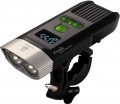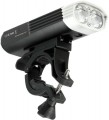Output
Luminous flux given out by a bicycle headlight (see "Type"); in models with adjustable brightness, usually, the maximum value is indicated.
The
higher the luminous flux, the brighter the headlight and the greater the illumination range (see below). On the other hand, this characteristic significantly affects the dimensions, weight and cost of the flashlight, despite the fact that high brightness is not always required — for example, for episodic trips along well-lit city streets, a powerful flashlight is not needed. Therefore, it is worth choosing a bicycle headlight according to the luminous flux, taking into account the features of the planned application; specific recommendations for different cases (city, highway, rough terrain, etc.) can be found in special sources. Also, do not forget that the actual lighting efficiency depends not only on the brightness, but also on the shape of the light spot.
Illumination range
The greatest range at which a bicycle headlight (see "Type") provides effective illumination. The criteria for what is considered effective lighting are very arbitrary and may be different for different manufacturers; therefore this figure is approximate. Nevertheless, it allows you to fairly accurately assess the effectiveness of the flashlight and is more visual than the value of the luminous flux (see above). It is also worth choosing a bicycle headlight according to the range, taking into account the intended application; here note that in some (especially inexpensive) models, “range” can be achieved by narrowing the beam and, accordingly, reducing the light spot.
Brightness modes
The number of brightness modes makes it possible to adjust the intensity of the flashlight and adjust it to the necessary needs. Accordingly, the more modes, the more flexible options for using the model (even not only in cycling needs). So the most popular are models with
brightness control in 3 or
4 positions.
Max. operating time
The longest time of continuous operation without replacing or recharging the power source, provided by a bicycle headlight (see "Type") in constant light mode (if there is a flashing mode, the operation time is usually longer, but it cannot be called the main one). This item indicates the value for the most economical format of operation, at minimum brightness; therefore, the actual headlight run time will generally be lower than advertised. It is also worth considering that many replaceable batteries (see "Power") are available in different capacities and have different durability — which means that battery life will also depend on the quality of the batteries. At the same time, this indicator is quite suitable for evaluating bicycle headlights and for comparing them with each other.
Max. brightness operation time
Bicycle headlight battery life at maximum brightness (see "Type"). This indicator is closer to reality than the maximum operating time (see above): in fact, it indicates the time that the flashlight is guaranteed to be able to work without replacing or recharging the battery. However note that some batteries (see "Power") can be produced in different capacities, and the manufacturer usually indicates the operating time for the most capacious (and expensive) batteries.
Power source
The type and number of batteries used by the bike light.
All elements, except for the proprietary batteries (see below), are removable and, usually, quickly replaced; many of them are available in two versions — disposable batteries and rechargeable batteries. The advantage of batteries is their low cost, but they need to be bought regularly; rechargeable batteries are noticeably more expensive, but once you buy a kit and a charger, you will no longer need to spend money on batteries.
—
AA. One of the most popular modern standard sizes. However, in bicycle lights, such elements are used infrequently — in particular, because of the relatively large size. There are many brands of AA batteries on the market, differing in capacity and, accordingly, operating time.
—
AAA. A smaller version of the AA batteries described above. Due to their compact size, they are well suited for bicycle lights; and the capacity of such batteries, although rather low, is quite sufficient, taking into account the specifics of use (flashing lights most often do not differ in significant power consumption).
—
CR2032. One of the most popular and largest types of coin batteries, with a diameter of 20 mm and a thickness of 2.3 mm. At the same time, the dimensions of such batteries are very compact, which, combined with good capacity specs, makes them very
...convenient for flashing lights. Typically, CR2032 cells are sold as disposable batteries.
— CR1025. Another type of coin battery is 10 mm in diameter and 2.5 mm thick. Due to their smaller size, they are noticeably inferior to RS2032 in terms of capacity, which is why they are used very rarely — mainly in flashing lights of low brightness, created with an emphasis primarily on compactness.
— LR44. Coin batteries (usually disposable) with a diameter of 11.6 mm and a thickness of 5.4 mm. The features are similar to those described above CR1025 but they are even rarer.
— LR01. Also known as LR1 or N. They are produced mainly in the form of disposable batteries, they are cylindrical, 30.2 mm long, and 12 mm in diameter (thus, LR01 is shorter than AAA battery, but noticeably thicker). Such batteries are considered optimal for devices with high current consumption. However, such devices are relatively rare among bicycle lights, and therefore LR01 has not received much distribution.
— 18650. Elements are usually made in the form of lithium-ion rechargeable batteries. Similar in shape to AA battery, but larger, with higher capacitance, and a higher voltage of 3.7V. 18650 cells are designed for high-power devices; therefore, in the case of bicycle lights, such power is a sign of a high-end model, with very high brightness levels and a long battery life. There are few such models on the market.
— Proprietary rechargeable batteries. This category includes all proprietary batteries that do not belong to any of the standard sizes, and often non-removable ones. In the case of bicycle lights, the convenience of the battery lies in the fact that it is immediately supplied in the kit. On the other hand, such a battery in the event of a discharge cannot be quickly replaced with a fresh one. However, the battery life is usually quite decent.USB charging port
The presence of a flashlight
USB-portused to charge the battery. Note that this can be either a full-size socket or a smaller version — miniUSB or microUSB; in this case, there is no fundamental difference between them. Any such connector makes the flashlight independent of branded chargers and allows you to charge it from any USB output — for example, in a computer or laptop. In addition, there are also separate chargers with USB ports that can be connected to sockets or car cigarette lighters. Thus, for many cyclists, this particular charging method is preferable.
Mount
—
Rigid mount. The mechanism for installing a bicycle lamp (flashing lights) on the frame or handlebars of a bicycle. Rigid design limits mounting space, but contributes to high reliability and a tenacious grip, as a result of which even aggressive riding will not lead to loss of the accessory.
—
Flexible mount. The method of fastening the device in the manner of a strap in a wrist watch. This method is more versatile, since it can capture not only the frame, but also a helmet, boot, etc. But in reliability it is inferior to the rigid mount described above.
—
Helmet mount. A variant of mounting a bicycle lamp on a cyclist's helmet. This is achieved thanks to special ventilation slots in the helmet and fastening fasteners on the harnesses. It is worth noting that this type of mount is found mainly in addition to the main rigid one, however, there are models where this is the only way to install a bicycle lamp.

